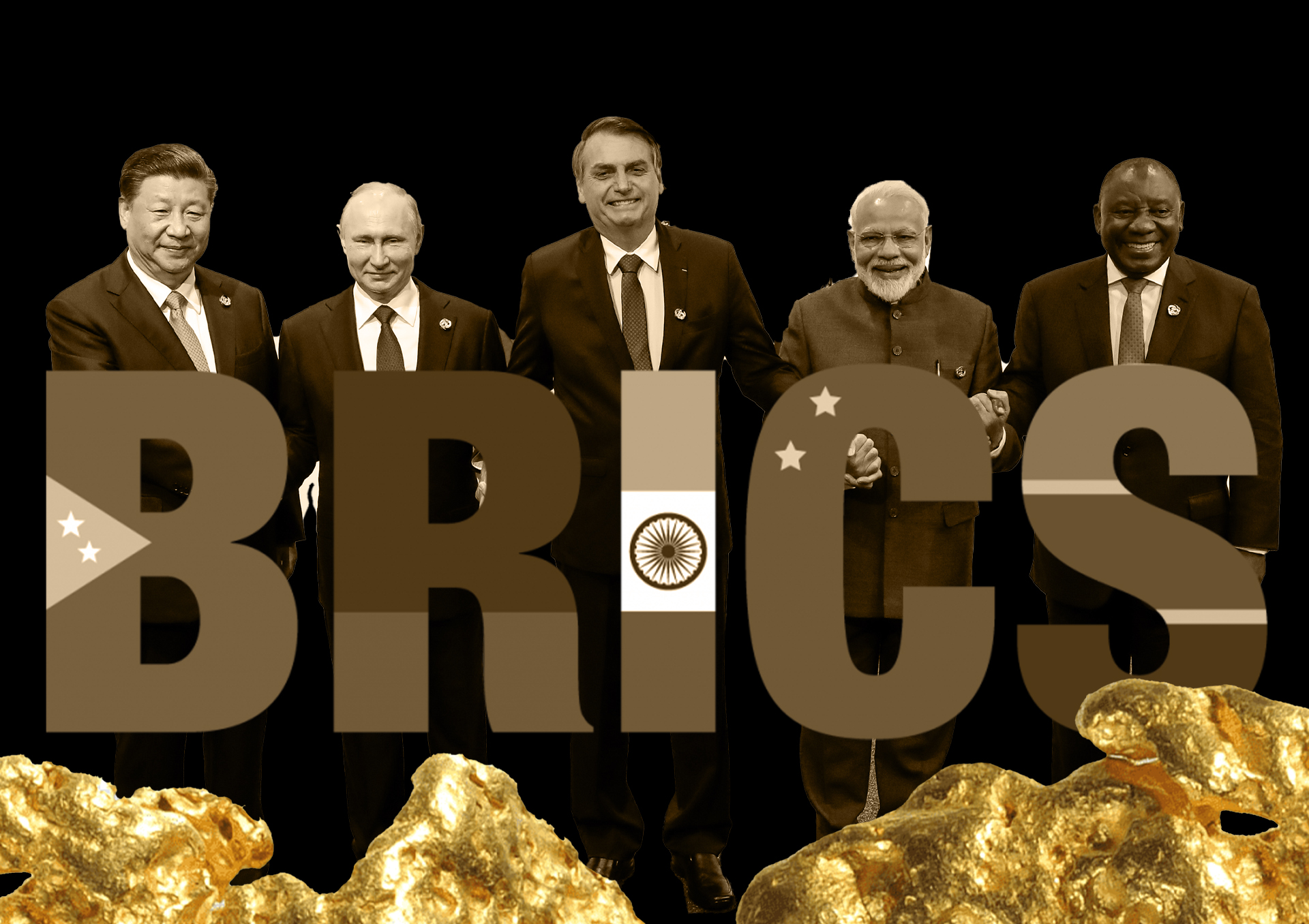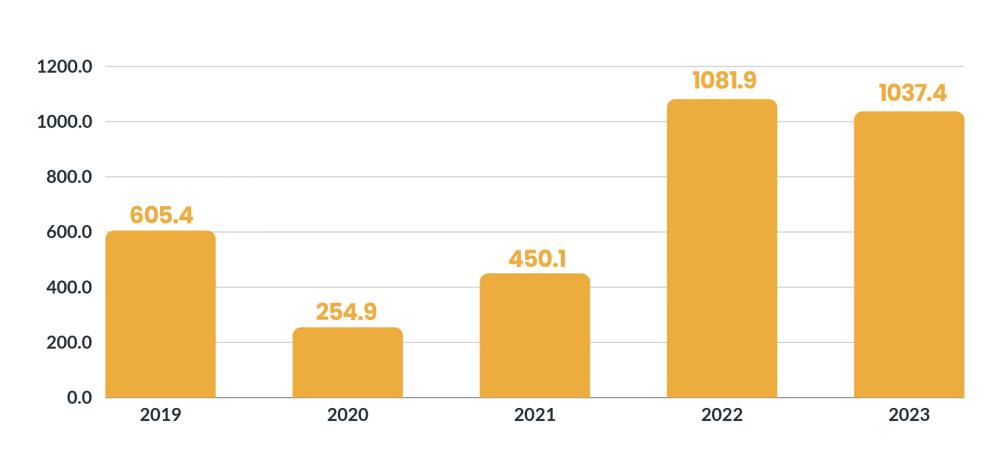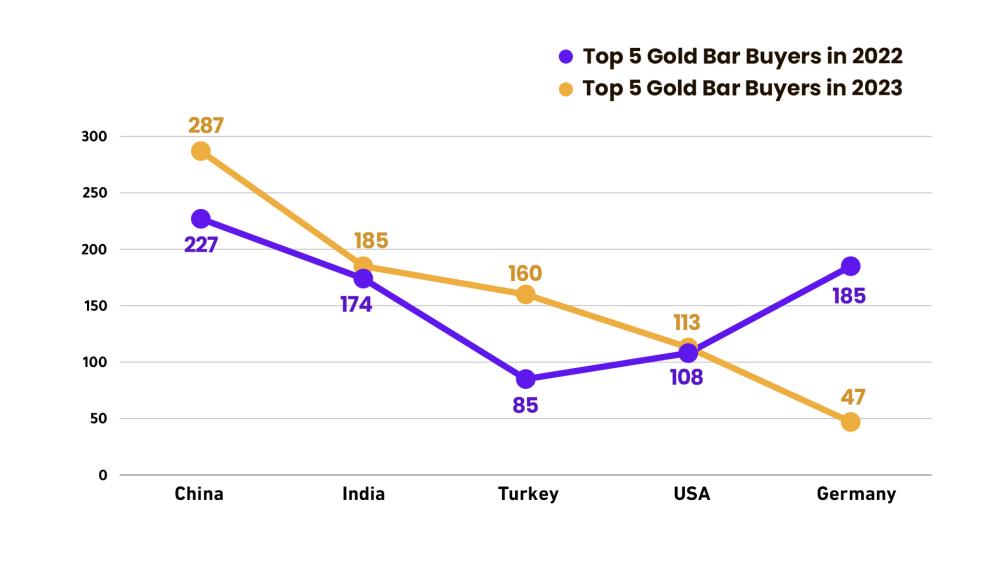كل عام وأنتم بخير،
برجاء العلم أن الفرع مغلق بمناسبة أعياد رأس السنة، وذلك اعتبارًا من الأحد 28/12/2025، على أن يُستأنف العمل واستلام الطلبات من الفرع يوم الأحد 4/1/2026.
هل تسعى البريكس للإطاحة بالدولار و إنشاء نظام عالمي جديد يعتمد على الذهب؟
- Home
- Information Center by DahabMasr
- هل تسعى البريكس للإطاحة بالدولار و إنشاء نظام عالمي جديد يعتمد على الذهب؟

هل تسعى البريكس للإطاحة بالدولار و إنشاء نظام عالمي جديد يعتمد على الذهب؟
نشأت مجموعة بريكس عام 2009 لتتكون من 4 دول وهم البرازيل، روسيا، الهند، الصين ثم انضمت جنوب أفريقيا لها العام التالي له، ويتمثل هدف المجموعة في تعزيز التعاون الاقتصادي والتجاري بين الدول الأعضاء وتنسيق المواقف في القضايا العالمية والإقليمية وتعزيز التنمية المستدامة، إلى جانب إصلاح النظام المالي العالمي وتعزيز دورها في عملية صنع القرار
.وفي عام 2014، قررت قمة بريكس المنعقدة في البرازيل إنشاء بنك للتنمية وتبني معاهدة لوضع احتياطي طارئ، فيما أيد أعضاء المجموعة فكرة إنشاء عملة موحدة بين الدول; كبداية لإيجاد نظام عالمي متعدد الأقطاب بدلا من الأحادي القطب الذي تقوده الولايات المتحدة
هل تنجح البريكس في تغيير مشهد الطاقة العالمي والإطاحة بالدولار
في أغسطس 2023، وافق تحالف بريكس على توسيع إجمالي أعضائه إلى 10 دول في مطلع 2024 لتشمل مصر – السعودية – الإمارات - إثيوبيا – إيران; كما أعلن التحالف عن تطوير عملة جديدة تُمكن من التخلي عن الدولار الأمريكي في التجارة الدولية والنفطية، وجاءت هذه الخطوة كجزء من خطة المجموعة لتسريع وتيرة استبدال الدولار كعملة نفطية من خلال دعوة كبرى الدول المنتجة للنفط للانضمام إليها ومن ثم تغيير مسار الطاقة العالم
هل عملة البريكس تعيد الذهب إلى مكانته في النظام المالي العالمي
ومن المتوقع أن تكون العملة الجديدة مدعومة بالذهب، ما قد يعزز الطلب على المعدن الثمين ويدعم اتجاهه التصاعدي خلال السنوات المقبلة ليظهر بذلك عامل جديد مؤثر في أسواق المعدن الأصفر العالمية; ومن المرجح أن يكون الذهب بمثابة إطار للمواجهة بين دول البريكس والدولار الأمريكي لبعض الوقت مع الزخم المتزايد لإطلاق ودعم العملة الجديدة
الذهب أصل النظام المالي
في 1971، أعلن الرئيس الأمريكي ريتشارد نيكسون (صدمة نيكسون) عن إلغاء التحويل الدولي المباشر من الدولار إلى الذهب، الخطوة التي أدت بشكل فعال إلى انهيار نظام بريتون وودز النقدي الدولي لما بعد الحرب العالمية الثانية (عام 1944) – الذي أُنشئ على المعيار الذهبي حيث كان يسمح بتحويل الدولار الأمريكي إلى الذهب بمعدل 35 دولارا للأونصة - وتم ربط العملات الرئيسية الأخرى بأسعار ثابتة مقابل الدولار. وبهذا القرار تم اعتماد النظام الحالي لأسعار الصرف العائمة
هل العقوبات الأمريكية على موسكو حافز إيجابي لتسريع وتيرة استبدال الدولار
:وفي الوقت نفسه، اتجهت روسيا والصين إلى التخلي عن الدولار تدريجيا خلال الفترة الماضية
مع بداية الحرب الروسية الأوكرانية وفرض عقوبات على الأصول النقدية الروسية، ظلت البلاد تبحث عن بدائل مالية أخرى لتحقيق الاستقرار الاقتصادي، ويبدو أن الذهب هو البديل المثالي
قيام الصين بالتجارة باليوان بدلا من الدولار، أدى إلى تحفيز دول أخرى لاستخدام عملاتها المحلية (مثل الهند ) و تخزين الذهب كاحتياطي نقدي لدعم أسعار عملاتها
ومع اتجاه كل من مجموعة البريكس إلى التوسع لتعزيز ثقلها في الاقتصاد العالمي وتزايد الاعتماد على الذهب في تأسيس النظام المالي الخاص بها، بجانب الاستمرار في محاربة العملة الخضراء فسيصبح الدولار مهدد بالخطر ويستعيد المعدن الثمين مكانته على عرش الأصول المالية الأكثر أمان
الذهب بديلا للدولار في احتياطيات البنوك المركزية
أظهرت بيانات مجلس الذهب العالمي استمرار تصاعد مشتريات البنوك المركزية في يناير الماضي بنحو 39 طنًا بقيادة تركيا (12 طن ) والصين (10 طن)، وفي فبراير بنحو 19 طنًا وقد توقع البنك أن يكون الطلب قويا خلال هذا العام ما يدعم توقعات وصول المعدن الأصفر إلى 3000 دولار للأونصة بنهاية العام
وقد سجلت مشتريات البنوك المركزية من الذهب نحو 1037.4 طن في العام الماضي – ثاني أعلى مستوى على الإطلاق - مقابل 1081.9 طن خلال 2022، وفي 2023، استحوذت البنوك المركزية في آسيا على نصيب الأسد من مشتريات الذهب، ثم أوروبا في المركز الثاني، الصين 225 طن، سنغافورة 77 طن، بولندا 130 طن. إذ تتجه البنوك المركزية حول العالم لحيازة المزيد من المعدن الثمين عقب الحرب الروسية الأوكرانية وما نتج عن العقوبات المفروضة من تجميد الأصول النقدية لموسكو، ومع تصاعد الديون الخارجية وارتفاع تكلفة الفائدة لخدمة الدين الحكومي في ظل السياسة النقدية التشديدية المتبعة منذ عام 2022

رسم بياني لمشتريات البنوك المركزية العالمية من الذهب
أبرز العوامل المؤثرة على الذهب في الساحة العالمية
أ) الزخم الشرائي للبنوك المركزية من الذهب يتسبب في إحداث خلل بين الطلب والعرض العالمي
أظهرت أحدث بيانات لصندوق النقد الدولي أن العملات الاحتياطية العالمية بلغت نحو 12 تريليون دولار، بينما قٌدرت مشتريات الذهب المتاحة إلى البنوك المركزية بحوالي 3 تريليونات دولار وفقا لما ذكرته مؤسسة الأبحاث الكندية ألباين ماكرو
ب) اتجاه المستثمرون الصينيون إلى شراء الذهب كملاذ آمن عقب انهيار سوق العقارات و الأسهم الصينية خلال عامي 2022-2023، حيث تشير البيانات إلى الابتعاد عن الاستثمار العقاري مع انهيار أسعار المنازل و زيادة المعروض منها، بالإضافة إلى توقعات بتراجع أعداد السكان خلال السنوات المقبلة

جدول مشتريات السبائك لأكبر 5 دول 2022 – 2023
:تنبيه
تقدم هذه الوثيقة تحليلاً تم إعداده من قبل قسم الأبحاث والتحليلات الخاص بشركة "ذهب مصر"، استنادًا إلى بيانات مستقاة من جهات عدة ذات مصداقية عالية. بالرغم من ذلك، لا تضمن "ذهب مصر" دقة هذه المعلومات والبيانات حيث أنها ليست المسؤولة عن إعدادها أو جمعها، وعليه لا تتحمل "ذهب مصر" مسؤولية أي أضرار أو خسائر مباشرة أو غير مباشرة قد تنتج عن الاعتماد على المحتوى الوارد بها. وأن استخدام هذا التحليل وأية قرارات تنتج عنه تقع مسؤوليته على عاتق القارئ وحده. كما توصي "ذهب مصر" بأن يستشير القراء مستشارًا ماليًا محترفًا قبل اتخاذ أية قرارات استثمارية



 EN
EN